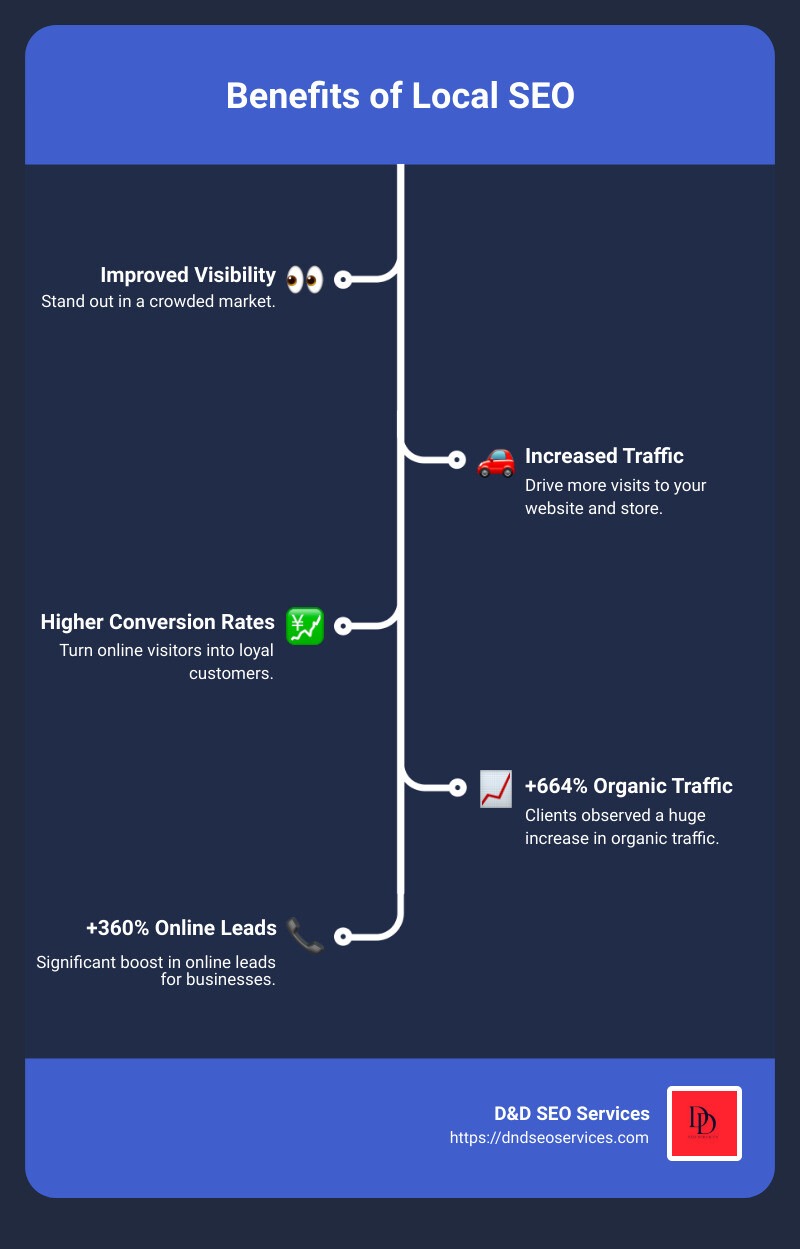Why Local SEO Matters for Medical Practices
Welcome! If you’re looking to improve your medical practice’s online visibility and attract more local patients, you’ve come to the right place. Local SEO for medical practices is essential for helping your clinic or health service rank higher in local search results and get noticed by nearby patients.
Here’s a quick overview of how to skyrocket your local SEO:
- Optimize Your Google My Business Listing
- Use Local Keywords Effectively
- Build and Manage Local Citations
- Leverage Social Media and Online Ads
- Monitor and Analyze Your Results
An optimized local SEO strategy not only boosts your online presence but also increases patient trust and improves your practice’s reputation.
I’m Danielle Birriel, founder of D&D SEO Services. With over a decade of experience in SEO and digital marketing, I’ve helped countless local businesses, including medical practices, improve their online visibility through targeted local SEO strategies.
Optimize Your Google My Business (GMB) Listing
Claim and Verify Your GMB Listing
First things first, claim your Google My Business (GMB) listing. This is crucial for local SEO for medical practices.
Why? Because it ensures your practice appears in local search results and on Google Maps.
- Sign in to Google My Business: Use your Gmail account. If you don’t have one, create it.
- Search for Your Practice: Look for your practice name. If it already exists, claim it. If not, create a new listing.
- Verify Your Listing: Google will send a postcard with a verification code to your practice address. Enter this code in your GMB account.
Pro Tip: Follow the verification process carefully to avoid any inaccuracies that could mislead patients.
Add and Update Information Regularly
Once your GMB listing is claimed and verified, it’s time to add and update the information.
Here’s what you need to include:
- Business Name: Ensure it matches exactly with your practice’s name on your website.
- Address: Include suite or office numbers. Mention if you’re inside a larger complex.
- Phone Number: Use your main practice number. Additional numbers like fax can be added.
- Business Hours: Make sure these are accurate and match your website. Update special hours for holidays or events.
- Website: Link to your practice’s website.
- Services: List all services you offer. Add a small description for each.
- Business Category: Choose the most specific category that fits your practice.
Fun Fact: Businesses with complete profiles are 50% more likely to convert leads into patients.
Encourage and Manage Online Reviews
Online reviews are a powerful tool for local SEO for medical practices.
Why? Because 90% of patients use online reviews to evaluate healthcare providers.
How to Get Reviews:
- Ask Patients Directly: Encourage patients to leave a review after their visit.
- Send Follow-Up Emails or Texts: Include a link to your GMB profile.
- Provide Handouts: Give patients a simple guide on how to leave a review.
How to Manage Reviews:
- Positive Reviews: Show appreciation and thank the patient.
- Negative Reviews: Apologize for their experience and ask them to contact you for more details.
Statistic: Reviews can boost your search rankings as Google sees them as a sign of quality and trust.
By optimizing your GMB listing, you ensure your practice is visible, trustworthy, and easy to find for local patients.
Next, we’ll dig into how to use local keywords effectively to further improve your local SEO efforts.
Use Local Keywords Effectively
Incorporate Keywords in Website Content
Using local keywords is crucial for local SEO for medical practices. These keywords help search engines understand where your practice is located and what services you offer.
Local Keywords:
Include your city name, state name, and region name in your website content. For instance, if your practice is in Miami, use phrases like “Miami pediatrician” or “best cardiologist in Miami.”
Specialty Keywords:
Combine local keywords with your medical specialties. For example, “Miami physiotherapy for back pain” or “Los Angeles dermatologist for acne treatment.”
Website Content:
Add these keywords naturally in your blog posts, meta descriptions, and other website content. This improves your relevance for local searches.
Meta Tags:
Ensure your meta tags include local keywords. For example, a meta description for a dentist could be: “Visit our Miami clinic for top-notch dental care, including cleanings, fillings, and more.”
Create Location-Specific Landing Pages
If your practice serves multiple locations, create unique landing pages for each area. This makes it easier for local patients to find you.
Unique Content:
Each location page should have unique content. Avoid duplicating information across pages. Mention local landmarks or community events to make the content more engaging.
Metadata:
Optimize each page’s metadata with local keywords. For instance, a page for a clinic in Coral Gables could have the title tag: “Best Dentist in Coral Gables | Quality Dental Care.”
URLs:
Use location-specific URLs. For example, “yourwebsite.com/miami-dentist” or “yourwebsite.com/coral-gables-clinic.”
By effectively incorporating local keywords and creating custom location-specific pages, you improve your chances of attracting local patients and boosting your practice’s online visibility.
Next, we’ll explore how to build and manage local citations to further improve your local SEO efforts.
Build and Manage Local Citations
Local citations play a crucial role in improving your local SEO for medical practices. They help search engines verify the legitimacy and relevance of your practice. Let’s dive into how to build and manage them effectively.
Submit to Top Directories
Start by submitting your practice to reputable local and industry-specific directories. Here are some essential ones to consider:
- Google My Business: This is a must. It’s often the first place patients find you.
- Yelp: A popular review site that can boost your visibility.
- Healthgrades: A key directory for healthcare providers.
- Yellow Pages: Still relevant for local searches.
- Bing Places: Another important search engine directory.
- Facebook: Create a business page to engage with patients.
- Apple Maps: Many users rely on Apple devices for navigation.
- Instagram: Showcase your practice visually.
Tip: When submitting to these directories, ensure that your NAP (Name, Address, Phone number) information is accurate and complete. Consistency here is key.
Ensure Consistency Across All Listings
Inconsistent NAP data can confuse search engines and hurt your rankings. Here’s how to avoid that:
- Uniform NAP Information: Make sure your practice’s name, address, and phone number are the same across all platforms. This builds trust with search engines and patients.
- Accurate and Complete Information: Beyond NAP, ensure that other details like business hours, services offered, and website URL are also consistent and up-to-date.
Fact: According to a Harvard Business Review study, businesses saw a 12% increase in reviews when they responded to customer feedback, highlighting the importance of managing online presence.
Tools like LocalFX can help manage your listings across multiple directories, ensuring consistency and saving you time.
By submitting to the top directories and maintaining consistent NAP information, you can significantly improve your practice’s online visibility and credibility.
Next, we’ll discuss how to leverage social media and online ads to further boost your local SEO efforts.
Leverage Social Media and Online Ads
Engage with Patients on Social Media
Social media platforms like Facebook, Instagram, and Twitter are powerful tools for boosting local SEO for medical practices. Here’s how to make the most of them:
1. Post Engaging Content Regularly
Keep your audience engaged with content that is relevant and valuable. Share health tips, updates about your practice, patient testimonials, and educational posts about common medical issues. For example, you can post tips on managing seasonal allergies or the benefits of regular health check-ups.
2. Respond to Patient Inquiries
Engage with your patients by promptly responding to their comments and messages. This shows that you care about their concerns and are available to help. Aim to respond to inquiries within 24 hours to maintain a positive and responsive online presence.
3. Maintain Consistent Information
Ensure that your business name, address, phone number, and website URL are accurate and consistent across all social media profiles. Inconsistent information can confuse patients and hurt your local SEO efforts.
4. Use Visual Content
Visual content like photos and videos can greatly increase engagement. Share before-and-after photos (with patient consent), short videos on health tips, or infographics about medical conditions. According to HubSpot, posts with visual content get 94% more views than text-only posts.
5. Partner with Local Influencers
Collaborate with local influencers to expand your reach. Influencers can introduce your practice to a wider audience and help build trust within the community. Identify influencers who align with your practice values and collaborate on content or community events.
Use Paid Search Ads
Paid search ads, like Google Ads, can help you reach patients who are actively searching for healthcare services in your area. Here’s how to make the most of them:
1. Choose Relevant Keywords
Select keywords that are relevant to your healthcare services and the needs of your target audience. For example, if you are a pediatrician in Chicago, use keywords like “pediatrician in Chicago” or “Chicago child doctor.”
2. Create Targeted Ads
Create ads that are custom to your audience. Use specific messaging that addresses their needs and highlights the benefits of your services. For example, an ad for flu shots could say, “Protect your family this flu season with our quick and easy flu shots.”
3. Monitor and Adjust Your Campaigns
Use tools like Google Analytics and Google Ads to monitor the performance of your ads. Track metrics like click-through rates, conversion rates, and cost per click. Adjust your campaigns based on the data to improve their effectiveness.
4. Use Location Targeting
Use location targeting to ensure your ads are seen by people in your area. This can help you attract local patients who are more likely to visit your practice. For example, you can target ads to people within a 10-mile radius of your practice.
5. Set a Budget
Determine a budget for your ad campaigns and stick to it. Start with a small budget and gradually increase it as you see positive results. This can help you manage your costs while maximizing the return on investment.
By leveraging social media and online ads, you can improve your local SEO efforts and attract more patients to your practice.
Next, we’ll explore how to monitor and analyze your results to ensure ongoing success.
Monitor and Analyze Your Results
Track Key Metrics
To skyrocket your local SEO for medical practices, you need to keep an eye on your performance. The best way to do this is by tracking key metrics using tools like Google Analytics and Google Search Console.
Google Analytics helps you understand your website traffic. You can see how many people visit your site, where they come from, and what they do on your site. Look at metrics like:
- Sessions: How many times people visit your site.
- Pageviews: How many pages they look at.
- Bounce Rate: How many people leave after viewing just one page.
- Conversions: How many visitors take a desired action, like booking an appointment.
Google Search Console shows you how your site performs in search results. It provides data on:
- Search Rankings: How high your site ranks for specific keywords.
- Click-Through Rate (CTR): How often people click on your site from search results.
- Impressions: How often your site appears in search results.
By tracking these metrics, you can see what’s working and what needs improvement.
Adjust Strategies Based on Data
Once you have the data, it’s time to make adjustments. Regular performance reviews help you understand trends and make informed decisions.
1. Identify Areas for Improvement
Look for patterns in your data. Are there keywords with declining rankings? Is your bounce rate high? Identify the weak spots.
2. Refine Your Content
Based on your findings, refine your content. If certain keywords aren’t performing well, consider updating your content to better match user intent. Long-tail keywords can be easier to rank for and attract more qualified traffic.
3. Build More Local Backlinks
High-quality backlinks improve your site’s authority. Focus on getting backlinks from local and authoritative sites. For example, a mention in a WebMD article is more valuable than a link from a lesser-known site.
4. Competitive Analysis
Keep an eye on your competitors. What are they doing that you aren’t? Tools like Ahrefs or SEMrush can help you see their strategies and find opportunities for your own site.
5. Test and Optimize
SEO is not a one-time task. Continuously test different strategies and optimize based on what works best. Whether it’s updating your meta descriptions, improving your site speed, or enhancing your mobile experience, always aim for better performance.
By monitoring and analyzing your results, you can make data-driven adjustments to your local SEO strategy, ensuring you stay ahead of the competition and attract more patients to your practice.
Next, we’ll answer some frequently asked questions about local SEO for medical practices.
Frequently Asked Questions about Local SEO for Medical Practices
What is Local SEO for Medical Practices?
Local SEO for medical practices is a digital marketing strategy focused on improving your practice’s online visibility in local search results. When potential patients search for healthcare services near them, local SEO helps ensure your practice appears prominently in those search results.
Why is it important? Because 97% of people use search engines to find local businesses, including medical practices. Effective local SEO can attract more patients by making it easy for them to find and trust your services.
How Much Does Medical SEO Cost?
The cost of medical SEO services can vary widely based on the scope of the project and the specific needs of your practice.
Monthly fees for professional SEO services typically range from $500 to $5000, depending on the complexity and competitiveness of your market. Some agencies may offer packages that include a variety of services like keyword research, content creation, and citation management.
Budget considerations include the size of your practice, your marketing goals, and the level of competition in your area. Investing in SEO is a long-term strategy that can yield significant returns by increasing your patient base and enhancing your online presence.
Why is Local SEO Important for Healthcare Practices?
Local SEO is crucial for healthcare practices for several reasons:
- Online Visibility: Appearing at the top of local search results increases your practice’s visibility, making it easier for potential patients to find you.
- Patient Trust: High search rankings build trust and credibility. Patients are more likely to choose a healthcare provider that appears prominently in search results.
- Competitive Advantage: In a competitive market, local SEO gives you an edge over other practices. Dominating local search results can lead to more patient inquiries and appointments.
By focusing on local SEO, healthcare practices can improve their online presence, attract more patients, and build a stronger reputation in their community.
Conclusion
At D&D SEO Services, we believe in the power of local SEO to transform medical practices. Our AI-driven solutions and personalized strategies are designed to help you dominate local search rankings and achieve sustained online growth.
By optimizing your online presence, we make it easier for potential patients to find you when they need your services the most. Our team understands the unique challenges faced by healthcare providers and tailors our approach to meet your specific needs.
Local SEO is not just about higher search rankings—it’s about building trust, enhancing credibility, and gaining a competitive edge. With D&D SEO Services, you can expect:
- Improved Online Visibility: Our strategies ensure that your practice appears at the top of local search results, making it easier for patients to find you.
- Improved Patient Trust: High search rankings build credibility. Patients are more likely to choose a provider that is prominently featured in search results.
- Sustained Growth: Our approach focuses on long-term success, helping you attract more patients and grow your practice over time.
Ready to take your practice to the next level? Contact D&D SEO Services today to open up the full potential of local SEO for your medical practice.
By leveraging our expertise, you can ensure that your practice stands out in a crowded market, reaches the right audience, and fosters lasting patient relationships. Let us help you achieve your goals and thrive in the digital age.








